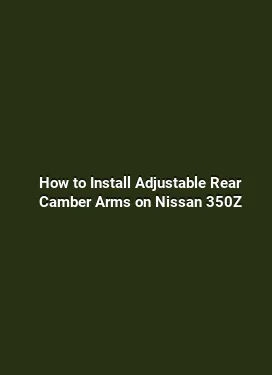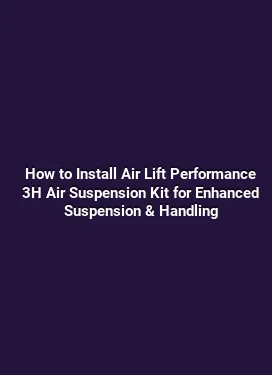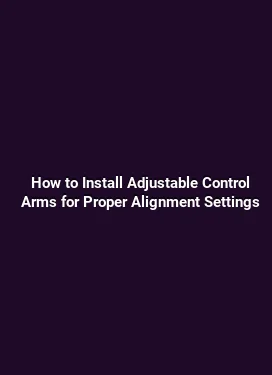Best Lifted Suspension Kits for Off-Road Modified Trucks
Rugged trails demand more than horsepower; they require a suspension system that can absorb rock gardens, whoops, and rutted trails while preserving steering control and ride quality. Lifted suspension kits are a cornerstone of off-road builds, enabling greater ground clearance, improved approach angles, and compatibility with larger tires. This guide dives into the most effective lifted setups for trucks, detailing the factors that influence handling, the types of kits available, practical installation tips, and real-world performance considerations that help enthusiasts choose the right package for their needs.
Understanding Lifted Suspensions and How They Affect Handling

A lifted suspension changes the geometry of the chassis, control arms, and anti-sway systems, which in turn influences ride quality, steering response, and stability at high speeds off-road. A larger tire contact patch can increase traction, but it also introduces new dynamics in braking, cornering, and suspension articulation. When selecting a kit, it is essential to balance clearance with the desired on-road manners, as a poorly tuned setup can lead to increased bump steer, driveline angles, or uneven tire wear.
Key mechanical adjustments in a typical lift kit

Most comprehensive lift kits include components that alter spring rates, dampening characteristics, and axle positioning. Depending on the vehicle and intended use, common inclusions are taller coil springs or spacers, upgraded shocks with extended travel, control arm elongation to restore correct pinion angles, and sway bar links or disconnects to maintain steering precision off-road. Properly matched components minimize alignment shifts and preserve predictable handling when transitioning from dirt to pavement.
Beyond springs and shocks, some kits incorporate a diff drop or a transfer case lowering option to maintain driveline angles, particularly on heavy-bodied trucks with long wheelbases. It's important to assess how these parts interact with traction devices, steering geometry, and brake lines to prevent binding or rubbing during suspension articulation. A well-balanced kit keeps tire contact patches even through compression and rebound, reducing the likelihood of body roll or toe change during dynamic maneuvers.
Key Factors to Consider When Choosing a Lifted Kit
Choosing the right kit hinges on several practical variables, including vehicle type, intended terrain, tire size, and budget. The following considerations help buyers align a kit with their goals and daily driving realities.
Intended terrain and articulation needs
For mild off-road excursions with occasional mud or gravel, a moderate lift paired with calibrated shocks can deliver improved ground clearance without sacrificing highway manners. In more technical environments—such as rock crawling or steep ledges—longer travel suspensions, reinforced axles, and higher-quality dampers become critical to maintaining traction and preventing mechanical interference during extreme articulation.
Articulation capability affects how well a vehicle can keep tire contact on uneven surfaces. A kit that emphasizes controlled travel over soft, plush dampers may suit rocky trails, whereas a firmer setup with tuned rebound might excel on whoops and fast sections. Matching spring rates to tire load and payload is essential to avoid excessive squat under acceleration or nose-diving under braking.
Wheel and tire compatibility
Wheel offset and backspacing determine whether larger tires will rub the fenders, control arms, or within the wheel wells at full lock. A lift kit should be paired with wheels that preserve adequate clearance and maintain steering geometry. When selecting tires, consider height, width, and sidewall stiffness, since these factors influence steering input and load transfer during off-road maneuvers. Wider tires can enhance flotation in loose conditions but may require fender trimming or additional inner fender protection to prevent debris intrusion.
Finally, a tire that is too tall for the suspension travel can cause unintended contact with the chassis during compression, leading to damage or unpredictable handling. A measured approach—selecting a tire size within the designed travel window and confirming with dynamic testing on varied terrain—helps maintain reliable control in demanding environments.
Drivetrain angles and drivability
Raising the ride height modifies axle position relative to the drivetrain, which can affect driveline angles, CV joints, and universal joints. Kits typically include components to restore driveline geometry, such as adjustable control arms or angled driveshafts. Without proper alignment, driveline vibrations and accelerated joint wear become common, especially at highway speeds. An upgrade to compatible CV joints, constant-velocity joints, or telescoping driveshafts offers smoother power delivery and reduces the risk of premature failure during long off-road days.
Popular Lifted Kits by Vehicle Type
Truck manufacturers offer a wide spectrum of platform options, from midsize pickups to heavy-duty workhorses. The following sections highlight widely respected configurations, while noting practical trade-offs for on-road comfort and off-road capability.
Mid-size pickups (example: 4x4 variants)
Mid-size pickups commonly use spacer or coil-spring lift strategies with monotube performance shocks designed for quick damping adjustments. These kits excel in urban environments while delivering improved ground clearance for trail sections. For enthusiasts who frequently run slick, wet surfaces, the upgraded dampers help maintain stability and reduce dive under heavy braking. When paired with 1.5 to 2.5 inches of lift, these setups typically allow room for up to 33-inch tires without major drivetrain modifications, making them a balanced choice for daily driving and playful weekend adventures.
On trail, these configurations benefit from upgraded steering stabilizers and reinforced sway bars to keep the vehicle planted during side-hill climbs. With careful alignment and properly rated springs, drivers experience predictable handling, enabling confident line selection and smoother transitions over rocky obstacles.
Full-size pickups
Full-size trucks often demand more robust components due to higher payloads and greater torque. Lifts in the 2.5 to 4-inch range are common, with paired long-travel shocks and control arm upgrades that accommodate larger tires (typically up to 35 inches or more, depending on the model). Key benefits include improved approach/departure angles and better obstacle clearance. A well-tuned kit retains steering feedback and minimizes caster changes that could otherwise alter steering feel at highway speeds.
For adventurers who haul gear or tow, an emphasis on axle articulation and bump-stop customization ensures the suspension maintains ride comfort under load. It is not unusual to see upgraded stabilizers and sway-bar disconnects to optimize wheel articulation without compromising on-road stability.
Tire, Alignment, and Handling Interdependencies
Lifted configurations interact closely with tire selection and alignment geometry. The broader picture includes camber, toe, and caster adjustments, all of which influence steering response, tire wear, and cornering behavior. When tires are taller, their contact patch changes, affecting grip distribution across the tread. Proper alignment ensures even tire wear and predictable turn-in. Regular alignment checks after installation help catch shifts caused by new suspension geometry and prevent irregular wear patterns.
Shocks play a crucial role in how the vehicle responds to terrain. A well-damped setup reduces bounce on rough surfaces and minimizes steering wheel jitter. In extreme off-road conditions, antisway bars can be a deciding factor in maintaining lateral stability, particularly when the vehicle is traversing side slopes or transitioning between obstacles at moderate speeds.
Installation, Tuning, and Maintenance Practices
Installation quality directly affects performance and reliability. A professional installation ensures correct torqueing of bolts, proper sensor calibration, and secure wiring for any electronic ride-height controls. Following the manufacturer’s torque specs and service intervals protects components from premature wear and maintains safe handling characteristics across the suspension range.
Tuning involves adjusting damping rates, bump-stop positions, and alignment parameters to suit the driver’s weight, load pattern, and preferred terrain. A practical approach includes staged testing across varied surfaces, recording feedback on steering response, braking stability, and wheel travel. For example, practitioners often begin with moderate adjustments, then incrementally increase stiffness on rough sections to reduce chassis oscillation without sacrificing ride comfort on smooth pavement.
Maintenance for lifted systems emphasizes inspection of extended travel shocks, control arms, and mounting points. Regular checks for wear on bushings, ball joints, and tie-rod ends prevent small issues from evolving into major failures in remote environments. Visual inspection after mud encounters or water crossings helps identify corrosion, leaks, or loose hardware before they escalate into safety concerns.
Real-World Performance Scenarios and Practical Tips
In challenging off-road events or weekend trail runs, the choice of lift kit is often guided by terrain type and driving style. For rock sections, a kit with longer travel and sturdier axles maintains tire contact with uneven surfaces, reducing the likelihood of getting stuck. In sandy or desert conditions, wider tires with moderate lift improve floatation, but may demand more precise steering input and careful throttle modulation to prevent bog-down.
Drivers should develop a habit of checking tire pressures for the given terrain. Lower pressures increase contact area on soft surfaces but can risk bead-seating issues on high-speed sections. Conversely, higher pressures improve on-road handling but reduce off-road traction. A practical approach is to carry a compact tire compressor and establish terrain-specific pressures before heading out.
Another practical consideration is addressing weight bias. If platforms frequently carry heavy cargo or tow trailers, adjusting the suspension to accommodate heavier loads will preserve even tire wear and consistent handling. This often means selecting a front-to-rear weight balance that keeps the vehicle stable during acceleration and deceleration, especially on uneven surfaces where shifting weights can provoke unexpected body roll.
Durability and Longevity Considerations
Off-road lifting components are subjected to harsh conditions—mud, water, vibrations, and heat. Choosing high-quality dampers, corrosion-resistant hardware, and reinforced mounts helps extend the life of the system. Many enthusiasts opt for sealed, monotube shocks with higher oil capacity and larger pistons to sustain performance across long, rugged journeys. Regular inspections after extreme expeditions are a recommended practice to catch signs of fatigue or leakage early.
Quality control during assembly matters as well. Ensuring proper alignment of longer control arms, correct installation of sway-bar disconnects (where used), and secure routing of electrical lines reduces the risk of interference with steering or drivetrain components. The cumulative effect of meticulous setup translates into more predictable handling and a longer service life for both the suspension and associated drivetrain parts.
Final Thoughts on Choosing and Using Lifted Kits
Choosing the right lifted suspension involves balancing ground clearance, off-road capability, and daily driving comfort. A thoughtfully selected kit, coupled with accurate tire sizing, careful alignment, and timely maintenance, delivers a more capable off-road truck without compromising on-road safety. The most successful setups are those that are matched to the driver’s needs, terrain preferences, and the vehicle’s overall build quality, ensuring reliability across a wide range of conditions.






